This discussion is with Linda and Miro, German comrades who did a speaking tour in the US in the fall of 2018. They have been antifascist activists for over 10 years and are part of the …ums Ganze! alliance. Both are involved in the campaign “Nationalism is No Alternative” that tries to finds answers to the new tactics of the extreme Right. This interview was conducted via email following discussions during their time in the US.
Their organization, …ums Ganze!, is an anti-capitalist, antiauthoritarian alliance currently consisting of eleven groups based in Germany and Austria. It was founded in 2006 in order to organize radical Left critiques and analysis in both theory and practice. The term “…ums Ganze!” can be roughly translated as “…to the whole (thing)!” and means that the alliance’s focus lies in an antiauthoritarian analysis and critiques which cover the whole complexity of the state, nation, and capital. …ums Ganze! made its first appearance during the anti-G8 protests in Heiligendamm, Germany in 2007.
This interview was conducted by the Perspectives on Anarchist Theory journal collective, a project of the Institute for Anarchist Studies (IAS).
Tell us about your organization(s). What are their roots in different political groups and movements of the past? What is their political orientation?
We are part of …ums Ganze!, which was founded in 2006 and is basically an alliance of anti-authoritarian communist groups. …ums Ganze! (uG!) is part of different struggles such as the feminist women‘s strike, confronting the housing crisis, and antifascism. We think that the very principles of capitalist society are the roots of these crises, so we do not advocate for reform or aim for a greener and more social capitalist society, but rather try to push for a social revolution. Therefore, we talk, fight together, and organize with people outside of leftist scenes and bubbles – at least we try to. Our aim is to actually win (there a some texts in English that can be found here: https://umsganze.org/other-languages/).
We have our roots in the German antifa movement. In the early 1990s, the radical Left collapsed and the fascist movement grew exponentially, especially in the former East Germany (GDR). Many within the strong subculture of autonomous anarchists thought antifascism was the most important struggle and joined antifa groups. But the autonomous antifascist movement was heavily divided between traditional anarchists who did not want to work together with unions, Social Democrats, or the media, and a more pragmatic wing who built large autonomous groups and tried to leave the subculture by strategically working with non-radical leftists. The latter groups sought to influence public opinion through media campaigns and by pushing popular youth culture to the Left through youth organizing. These large antifa groups and their strategic concept was to be openly radical, anticapitalist, and anti-state, but also to be accepted by normal people and able to actually build power in your town or city through self-organized but very committed groups: these are the roots we are coming from. uG! is also part of a European network of antiauthoritarian groups called Beyond Europe (https://beyondeurope.net/).

Discuss the idea of being “post-antifa.” Can you put this idea into historical context? How has the German antifascist movement developed after struggling so long against neo-Nazis? What lessons do you have from this struggle that you bring into your work today?
In the early 2000s, the antifascist movement was entrenched in bitter discussions and split up along various lines. For example, the Left leaning government started to mobilize society, and sometimes even the police, against fascists, sometimes the state even supported antifascist education programs with money, so the antifascist movement had to reevaluate what they thought of the state. Also, they discussed what to think about 9/11. Some thought the Islamist jihadists were allies in the fight against the imperialist United States, while others thought it was another form of fascism that needed to be fought against. Some of those antifascists were even in favor of the “global war on terror” and the invasion of Iraq. (We think that neither is correct).
Some in the antifascist movement and in the broader radical Left discussed how to be successful outside of antifascist struggles and rebuild the radical Left, since antifascism often did not have the answers for many urgent problems. For example, in 2005, the government composed of the Social Democrats and the Greens slashed unemployment benefits and introduced a benefit system that pushed a lot of people into poverty and consisted of degrading procedures. Antifascists criticized the movement against these cuts for its reformism and tried to push fascists, anti-Semitic conspiracy theorists, and other enemies of emancipation out of the movement, which is a very important job. But they were unable to present a credible way forward that would lead to improving living conditions.
In order to build a radical Left that is part of social movements and able to radicalize and win, two new organizations were formed: the interventionistische Linke (Interventionist Left) and …ums Ganze! Both are called “post-autonomous” and “post-antifa” since we are trying to use the experiences of the autonomous and antifa movement but use them in different social struggles, as well as to organize outside of autonomous subcultures without repeating the mistakes the orthodox communists usually make when they build their hierarchical party structures.
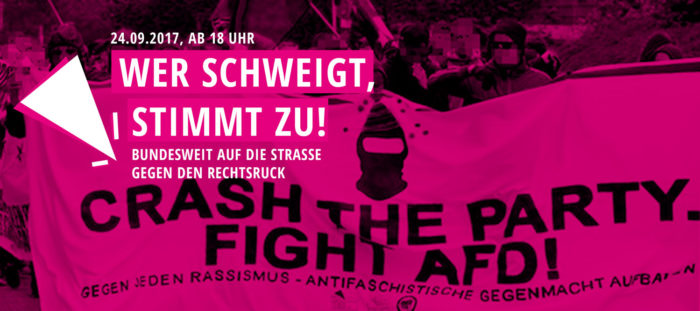
How has the movement and its various organizations responded to the rise of the Alternative for Germany (Alternative für Deutschland (AfD))? How have you adapted and changed tactics in response? Is this party continuing to grow, or have they reached their peak and are starting to decline?
Alternative for Germany, the AfD, even though it is now controlled by fascists, is not a traditional neo-Nazi party. They employed tactics that you probably know well from Donald Trump‘s campaign. They present themselves as rebels against an imagined leftist elite that has nothing but contempt for the average working person(!). They disguise their racism as concern for “cultural preservation,” make use of conspiracy theories, and appeal to older men by marking feminism and feminists as enemies. They don’t give a fuck about the truth and are happily contradicting themselves. They are kind of clever in using both social media and the traditional media.
In the last national election in 2017, the AfD won 13% percent of the vote and therefore now has 94 members of parliament and all the infrastructure and money that comes with that. In some parts of Eastern Germany, the AfD passed the Conservative Party and is now the leading party, polling at 25%. The next local elections in these states this fall of 2019 can yield significant gains for the AfD. The European elections this spring showed that, in many areas, the AfD stabilized their outcome somewhere between 8% and 15% of the vote. So, except for several large regions in Eastern Germany, they are neither growing nor declining.
With the help of some billionaires’ money and support from the media, the AfD was and is able to push their narrative. The established parties (mostly the Social Democrats and the Conservatives) reacted by condemning the AfD as an organization but moved themselves to the right, and incorporated the AfD‘s politics into their own programs and rhetoric.
In part, the antifascist movement has had to adapt its tactics to the new threat. Traditional neo-Nazi skinheads can be doxxed, and most people are unhappy when they learn about the neo-Nazi background of their neighbor or co-worker. But antifascists experienced that doxxing an AfD party official – in a country where at least 15% of the population support the party – is not causing any problems for the party official; it is, rather, considered free publicity. When antifascists show that the party official is an anti-refugee racist and bigot, many people do not have a problem with that. They voted for him because he publicly stands for that. Another problem is that the AfD‘s organizing today is, to a large degree, done online, and we have not yet found a way to deplatform their Whatsapp chatgroups and Facebook pages. The rallies of the fascist movement are a mere spectacle to provide content for fascist YouTube channels. So, antifascists may be able to stop people from going to those rallies, but that does not help because they are able to listen to the speeches on their computers.
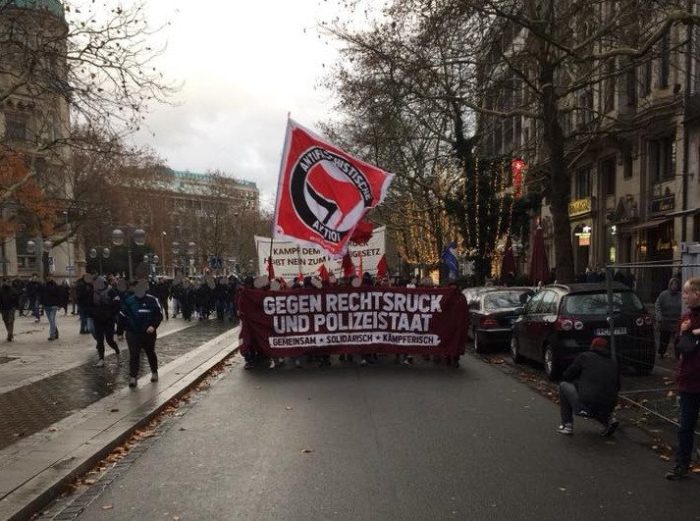
To be fair, some of the old militant antifascist tactics are still working fine. In some urban areas where the movement is strong, militants are able to put so much pressure on AfD members that the party is unable to build local structures, because it is just no fun to be the face of the AfD in some cities. Also, all over the country, antifascists were able to get a lot of party meetings canceled by putting pressure on venues. For example, the campaign “Kein Raum der Afd” (No Space for AfD) researched the pubs in Berlin where the AfD would hold their meetings and put pressure on them. Right now, it is impossible to find any restaurant or bar within Berlin that is still willing to host AfD events.
Right now, we’ve learned from the success of the AfD that just doing basic antifa work – meaning following the fascists around and trying to counter each of their moves – is important but not enough. We have to think about how to build a strong radical Left that has answers for the problems of our time. So, we are trying to update our own movement. We came up with a campaign called “Nationalism is No Alternative” (NIKA). NIKA is not trying to convince AfD voters not to be fascist anymore, but rather tries to organize all those young people who are outraged by AfD rhetoric. In order to do that, we have stepped up our social media presence, updated our style, and held easily accessible, open meetings that everybody who is willing can attend. But we do not disguise our politics; we are still openly anti-capitalist and anti-state.
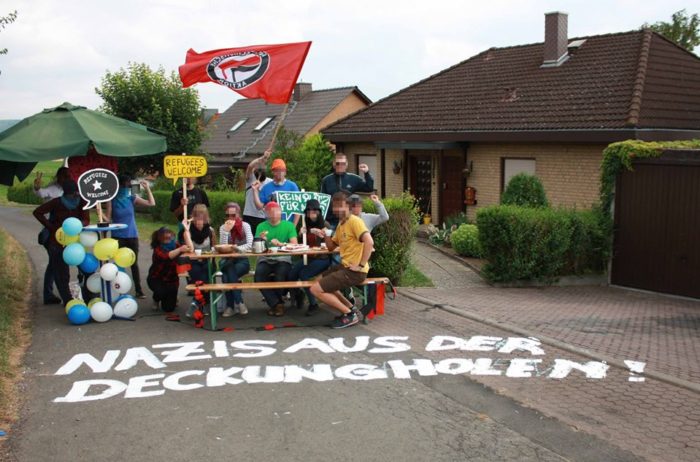
What is the overall political situation in Germany now? What are the prospects for fundamental social change there? What are the reasons for despair? What are the reasons for hope?
In the years directly following 2015, the right was able to mobilize tens of thousands in the streets. It was a proper movement. Right now, the dynamic phase is (temporarily) over, even though they still have the groups and networks to restart mobilizing masses if the occasion arises. We saw that in late August, 2018 in Chemnitz. Following the murder committed by a refugee, a local rightwing party, the AfD, and fascist football hooligans organized huge demos and attacks on perceived migrants and leftists.
The right is now settling and establishing themselves. They are building structures that are here to stay, which is very dangerous. So now we have a situation where the right is still very motivated from their earlier successes, and that is also dangerous. In the last two years, there have been several cases of right-wing terrorism committed either by people that were part of the new right-wing movement or have been neo-Nazis for a long time and felt that now is the time to act. In June, 2019 a neo-Nazi murdered a Conservative Party politician on his porch because he took a pro-refugee position in 2015. Also, the fascists within the state have seemingly woken up: leftist media uncovered a network of police and military special forces who built their own terrorist infrastructure and trained for civil war. One chapter of this group already ordered 200 body bags and kept a list of 25,000 people they wanted to kill (https://taz.de/taz-Recherche-auf-Englisch/!5558072/).
But society is not just moving to the right; rather, it is polarizing. The Left is still pretty small and our organizations are weak, but we are more able to intervene in debates today. There is a huge new movement to stop climate change that is openly confronting the fossil fuel industry; in many major cities there are big leftist movements against the rent increases; and in Berlin, there is a large movement pushing to expropriate every business that owns more than 3,000 apartments in the city. While the AfD dominated the talk show debates in 2015, now they aren’t even invited anymore, and that is not because the TV stations suddenly learned about the importance of deplatforming fascists, but because the AfD don’t have any answers apart from “close the borders” or “deport refugees.” Being able to dominate the public discourse around key topics such as the housing crisis or climate change is important antifascist work.

Looking at what is going on in the US from Germany now, what are your observations? How would you compare what you see happening here to what you are experiencing in Germany?
A lot of things are quite similar: we both live in a society where a lot of people feel that there are hard times coming and that the standard of living will decline. They think, therefore, it is a good idea to keep competition out by building border fences, etc. The countries are heavily divided, and the right is established or even hegemonic in parts of the country. In both countries, the antifascist Left seems to be able to confront the fascists in the streets, but in our opinion needs to think more about the fascists within the established institutions, such as the secret service, the police, the military, official politics, and important think tanks. The fascists seek to transform society very subtly, and there is little to be done about that with small demos and small-scale affinity groups.
When we went to the US, we got a feeling of how much more the police and the fascists are militarized. Also, life seemed harder with the horrible healthcare system. We felt so much respect for all the comrades who get up and fight and risk getting injured or imprisoned.

What lessons can you share from your experience fighting fascism, sexism, racism and nationalism in Germany to those of us struggling against these things here in the US?
The main things we are thinking about right now are to not just think about how your activity helps to push back the enemy, but to always aim to build your own movement, as well. Does this activity help to convince and organize my target audience? Who is my target audience? And maybe, how do we break through our isolation and start talking to people who are not yet convinced?
If you liked this interview please support our work. You can make a one-time donation – or become a monthly sustainer – to the IAS, the organization that produces Perspectives on Anarchist Theory (who did this interview) by clicking Here!
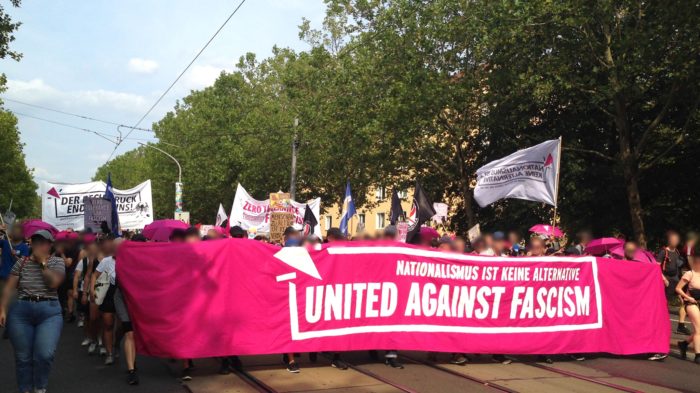

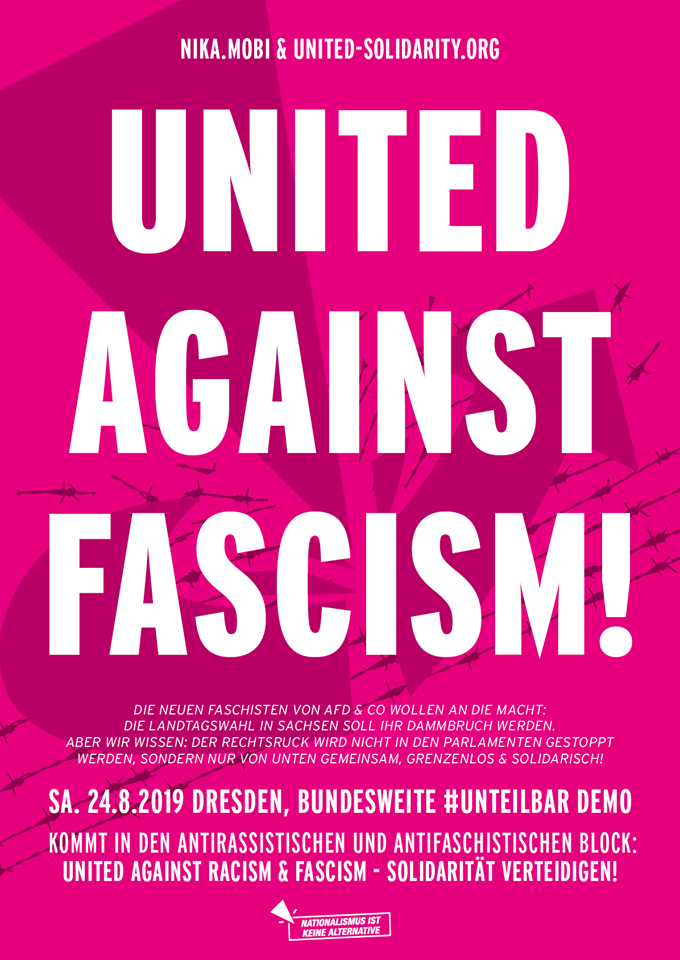
2 thoughts on ““Push Back the Enemy, and Build Your Own Movement:” An Interview with German Antiauthoritarian Antifascists”
Comments are closed.